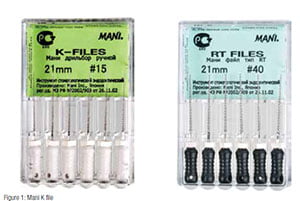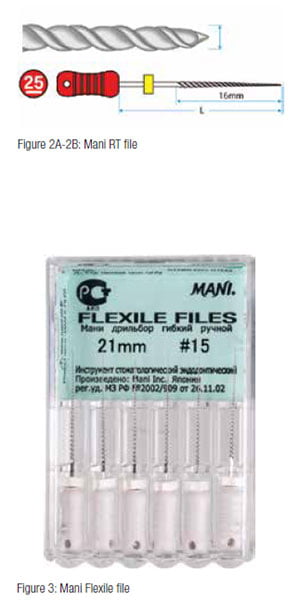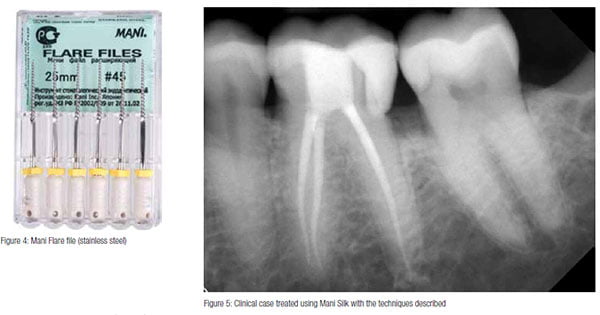Dr. Rich Mounce discusses clinical relevance and uses for four hand file classes
 Hand files are to an endodontist what brushes are to a painter. Different brushes have different characteristics providing the artist with functional options. Similarly, the file’s metal and geometry provide its functional characteristics. This clinical product feature will highlight four hand file classes to discuss their clinical relevance and uses. I have extensive experience with each of the hand files described; hence, Mani® products will be referenced. Specifically, Mani K (universal), RT (efficient cutting), Flexile (K Flex® type “flexible” hand file), and Flare (.05 tapered hand files manufactured in stainless steel and nickel titanium) will be briefly described.
Hand files are to an endodontist what brushes are to a painter. Different brushes have different characteristics providing the artist with functional options. Similarly, the file’s metal and geometry provide its functional characteristics. This clinical product feature will highlight four hand file classes to discuss their clinical relevance and uses. I have extensive experience with each of the hand files described; hence, Mani® products will be referenced. Specifically, Mani K (universal), RT (efficient cutting), Flexile (K Flex® type “flexible” hand file), and Flare (.05 tapered hand files manufactured in stainless steel and nickel titanium) will be briefly described.
 Mani K files (6-140) are a “universal” staple of the endodontic clinician’s armamentarium. They are relatively sharp at their tips due to the acute cutting angle formed at the transition of the tip and the flutes. K files are intermediate in stiffness between Flexile files (discussed below) designed for flexibility and cutting effectiveness and that of Mani D Finders which are manufactured purely for stiffness to gain patency in curved and calcified canals.
Mani K files (6-140) are a “universal” staple of the endodontic clinician’s armamentarium. They are relatively sharp at their tips due to the acute cutting angle formed at the transition of the tip and the flutes. K files are intermediate in stiffness between Flexile files (discussed below) designed for flexibility and cutting effectiveness and that of Mani D Finders which are manufactured purely for stiffness to gain patency in curved and calcified canals.
Mani K files are square in cross section from sizes Nos. 6-40 and triangular from sizes Nos. 45-140. Mani K files are used with a quarter turn and vertical pull (Figure 1). Mani K files are also available in “medium” sizes (12, 17, 22, 27, 32, and 37) and available in a “safe-ended” variety, which does not possess the acute cutting angle mentioned above (Mani SEC O K files).
Mani RT files are designed for efficient cutting by clinicians who want to shape canals by hand. They have approximately 1.5 times the cutting force of standard Mani K files and yet are also somewhat flexible. The file has two cutting edges provided by a modified rectangular shape in cross section (Figures 2A-2B). RT files are available from sizes 15-80 and used with a quarter turn and vertical pull. These instruments are very popular in countries where hand filing predominates due to the cost of nickel-
titanium instruments.
Mani Flexile files (15-40) are triangular in cross section making them approximately 2 times more flexible than K files. Flexile files are not intended for use with any significant degree of vertical pressure. Rather, in curved anatomy, especially for the creation of deep body shape at the juncture of the middle and apical third, they enlarge canals using the same quarter turn and pull of the files above. Use of Flexile files is a matter of personal preference relative to RT files. Triangular files below a size No.15 are not stiff enough to be clinically useful; hence, the first Flexile file size is a No.15. Mani K files, RT files, and Flexile files are all .02 tapered and made of stainless steel (Figure 3).
 By contrast, Mani Flare files (15-60) are .05 tapered and come in a stainless steel and nickel-titanium (NiTi) version. In addition, the stainless steel version of the Mani Flare files is available in medium sizes (12-37). Flare files, due to their larger taper, are triangular in cross section to provide optimal flexibility. Used with a quarter turn and vertical pull (as described earlier), these instruments are designed to create larger canal taper using a hand instrument. Mani NiTi files (15-40) provide shape memory and greater flexibility than their stainless steel counterparts (Figure 4).
By contrast, Mani Flare files (15-60) are .05 tapered and come in a stainless steel and nickel-titanium (NiTi) version. In addition, the stainless steel version of the Mani Flare files is available in medium sizes (12-37). Flare files, due to their larger taper, are triangular in cross section to provide optimal flexibility. Used with a quarter turn and vertical pull (as described earlier), these instruments are designed to create larger canal taper using a hand instrument. Mani NiTi files (15-40) provide shape memory and greater flexibility than their stainless steel counterparts (Figure 4).
Clinically, there are an infinite number of ways these files can be used separately and in combination. While the trends in endo-dontics are to use fewer files, it is axiomatic that the more complex the anatomy to be treated, the more instruments realistically will be required.
One illustrative clinical scenario would be the use of the Complex pack configuration of Mani Silk™ (.08/25, .04/25, .04/20) (or a similar nickel-titanium system) in combination with the files as described, in a severe three-dimensional apical curvature. After achieving straight-line access, the .08/25 Mani Silk orifice opener shapes the canal to the point of first curvature. After gaining patency and preparing a glide path created using Nos. 6, 8, 10, 12, and 15 hand K files, the Mani Silk .04/20 is inserted followed by the .04/25. If for any reason neither of these files will track the canal easily to its terminus, a No. 15 Flexile file or RT file can be used initially followed by either a No.17 medium Flexile file or No. 20 RT file as appropriate. The canal can be sequentially enlarged by hand using Flexile or RT files until the Mani Silk (or other rotary file) will advance effortlessly down the canal. In essence, in this scenario, the Flexile and/or RT file is used a bridge where needed to gain shape around the problematic area of curvature without ledging and, by doing so, reduce any NiTi fracture risk. After adequate shape is acquired by hand filing as described, the canal is finished via any standard shaping protocol.
Clinically, there are an infinite number of ways
these files can be used separately and
in combination. While the trends in endodontics
are to use fewer files, it is axiomatic that
the more complex the anatomy to be treated,
the more instruments realistically will be required.
For doctors who are hand filing, using Mani Gates Glidden drills in the coronal and middle half of the canal to the point of first curvature is followed by hand filing potentially by all four Mani file types, if desired, or whatever combination is most efficient. For example, the apical third can be negotiated with K files or D Finders, shaped with Flexile files and RT files, and finished to the appropriate final taper with Flare files (in either the stainless steel or nickel-titanium variety).
A brief overview of Mani K, RT, Flare, and Flexile files has been presented. Emphasis has been placed on using the appropriate file for the given clinical indication. While there is some overlap between the functionality of various files, these file types represent a universal (K files), efficient cutting with flexibility (RT files), primarily flexible (Flexile), and tapered files that cut dentin effectively (Flare files in stainless steel or nickel titanium).
Stay Relevant With Endodontic Practice US
Join our email list for CE courses and webinars, articles and more..


